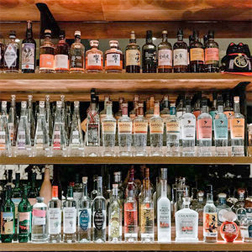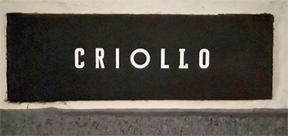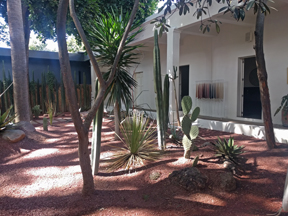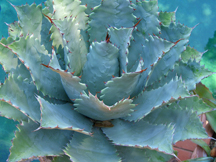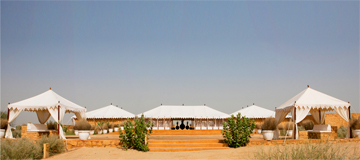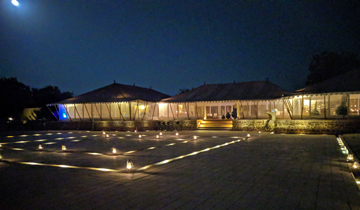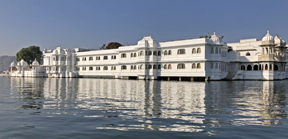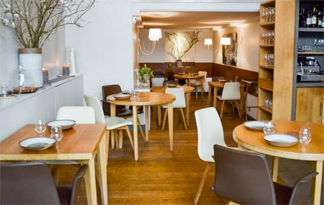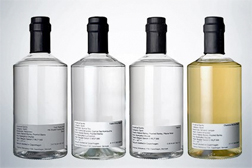 On our first visit to Bastard Restaurant in Malmö, Sweden we had learned about some interesting distillates produced by a new company called Empirical Sprits. We returned to the restaurant the next evening, intent on a full tasting. We get lucky again with two walk-in bar seats, within a couple of minutes....the staff seems surprised—and happy—to see us again. We tell Sean the bartender that the reason is primarily to do the Empirical Spirits comparison—and as an aside to have some delicious food. So he lines up all four that are available, 2cl each in small chimney tasting glasses (these spirits are sold by the cl, in whatever amount you wish—they are not inexpensive)—he doesn’t deem there to be necessarily a proper order, and we proceed through a fascinating tasting.
On our first visit to Bastard Restaurant in Malmö, Sweden we had learned about some interesting distillates produced by a new company called Empirical Sprits. We returned to the restaurant the next evening, intent on a full tasting. We get lucky again with two walk-in bar seats, within a couple of minutes....the staff seems surprised—and happy—to see us again. We tell Sean the bartender that the reason is primarily to do the Empirical Spirits comparison—and as an aside to have some delicious food. So he lines up all four that are available, 2cl each in small chimney tasting glasses (these spirits are sold by the cl, in whatever amount you wish—they are not inexpensive)—he doesn’t deem there to be necessarily a proper order, and we proceed through a fascinating tasting.
Lars Williams and Mark Emil Hermansen started the distillery in a former shipyard in Copenhagen. These are the guys who were in charge of fermentation and foraging at noma, and when the restaurant was temporarily shut down to relocate, they struck out on their own. They created a low-temperature, high-pressure vacuum still, which allows the alcohol to evaporate at cooler temperatures, enabling the retention of subtle flavors and aromas that would otherwise be heated away in a normal higher-heat distillation.
the guys who were in charge of fermentation and foraging at noma, and when the restaurant was temporarily shut down to relocate, they struck out on their own. They created a low-temperature, high-pressure vacuum still, which allows the alcohol to evaporate at cooler temperatures, enabling the retention of subtle flavors and aromas that would otherwise be heated away in a normal higher-heat distillation.
We elect to taste these "blind"— providing our own impressions before reading the lables. Left-most in the lineup is called Fallen Pony—completely clear...nose of...cherry, maybe? A bit of spice? Cherry or some sort of fruit carries through into the taste, as well as a bit of something herbal. Incredibly smooth, round, no heat at all. Sure ‘an I’d 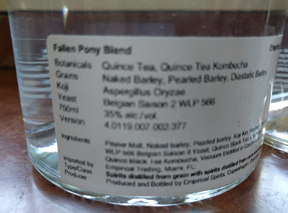 buy this stuff! Apparently each new release sells out almost instantaneously. The official description is:
buy this stuff! Apparently each new release sells out almost instantaneously. The official description is:
An aromatic double-fermented quince-tea spirit made from a base of quince, barley koji, Belgian Saison yeast, and pilsner malt wash. The spent fruit material is fermented into a quince tea kombucha, vacuum distilled and then used to rectify the final product to preserve the sweet botanical notes, highlight hints of marzipan, and provide balanced acidity.
Next up is the one we sampled last night, which gave us such laughs. It’s their newest offering titled “Fuck Trump and his Stupid Fucking Wall.” It’s based on Habanero pepper, and you can smell it as soon as the bottle is uncorked. Not hot in the mouth at all, but a bit acid, which becomes clear from the distiller’s description:
Fuck Trump and His Stupid Fucking Wall is a refreshingly smooth, warm, vegetal tasting habanero spirit made from a base of naked and pearled barley, Belgian saison yeast, and koji. The clear product is modified with a habanero vinegar that gives it a low 27% alcohol that imparts an intensely fruity habanero profile without any of the heat, preserving the floral and fruity notes typically hidden in habaneros.
Third in line is Helena, again a crystal clear spirit. No fruit or botanicals in the nose, but just a warm, smooth, 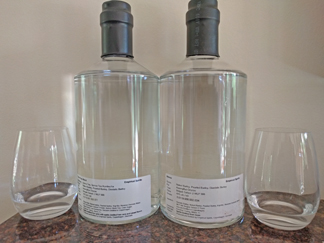 round, unctuous, long lasting sensation in the mouth. The closest thing I could compare it to is an ultra-premium grappa. The distillery says:
round, unctuous, long lasting sensation in the mouth. The closest thing I could compare it to is an ultra-premium grappa. The distillery says:
Helena is our most unadorned product: a double fermented clear spirit. Made from barley koji, pilsner malt, and Belgian Saison yeast, this product blends Eastern and Western fermentation methods to create a smooth base spirit with subtle nutty aromas and a delicate sweet barley character. Koji provides a signature flavor profile that yields a sweet, umami, and floral note.
The only colored spirit, a slight chestnut hue, is called Charlene McGee. Definitely a smoky nose, but not in the sense of peat-smoked scotch...it’s an herbal smoke, with a bit of spice, and I know there’s juniper in it. It’s delightful, and would be enjoyed by anyone that likes a peaty scotch. The house line is:
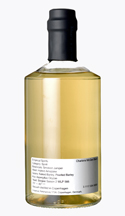 Charlene McGee is a juniper spirit inspired by the Scandinavian culinary tradition of smoking. Juniper berries are smoked with their own wood, lightly crushed, macerated, and gently distilled at low temperatures to preserve the fruity, vibrant integrity of the botanical and the smoky flavor profile. The final blend is matured in Oloroso casks to impart a faintly sweet hint of woodiness. The spirit has base notes of fresh juniper, fruity blackberries, and resinous, fragrant juniper sap that leaves a smooth, smoky finish.
Charlene McGee is a juniper spirit inspired by the Scandinavian culinary tradition of smoking. Juniper berries are smoked with their own wood, lightly crushed, macerated, and gently distilled at low temperatures to preserve the fruity, vibrant integrity of the botanical and the smoky flavor profile. The final blend is matured in Oloroso casks to impart a faintly sweet hint of woodiness. The spirit has base notes of fresh juniper, fruity blackberries, and resinous, fragrant juniper sap that leaves a smooth, smoky finish.
What an experience. Our dread-locked Jamaican waiter friend from the night before is off duty tonight but having a glass at the end of the bar, and gives us thumbs up when he sees what we are up to. When we’ve sipped each once, he announces his favorites—Fallen Pony and Helena, for sure!
The company website for more information is https://shop.empiricalspirits.co but unfortunately, they can not yet ship to the US. Domestique Wines carries some of their products—domestiquewine.com.
 Tuesday, May 21, 2019 at 07:41PM
Tuesday, May 21, 2019 at 07:41PM 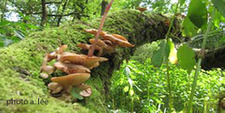 New Nordic Cuisine was introduced as a concept several years ago by Rene Redzepi and Claus Meyer with the restaurant noma. Seasonal and locally foraged and sourced ingredients; traditional regional cooking methods (smoking, curing, open-wood fires) and innovative and creative combinations define the style. We’ve tried Baltic versions in Latvia, Estonia and Lithuania; Scandinavian in Finland, and Norway; and on a recent trip, had some great dining experiences in Copenhagen, Denmark and Malmö, Sweden.
New Nordic Cuisine was introduced as a concept several years ago by Rene Redzepi and Claus Meyer with the restaurant noma. Seasonal and locally foraged and sourced ingredients; traditional regional cooking methods (smoking, curing, open-wood fires) and innovative and creative combinations define the style. We’ve tried Baltic versions in Latvia, Estonia and Lithuania; Scandinavian in Finland, and Norway; and on a recent trip, had some great dining experiences in Copenhagen, Denmark and Malmö, Sweden.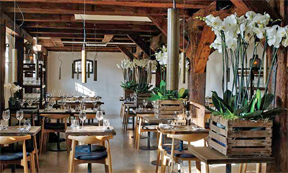 The restaurant in our hotel, 71Nyhavn in Copenhagen is called sea by Kiin Kiin—part of a restaurant group whose flagship Kiin Kiin has a Michelin star. It is Thaï influenced Nordic cuisine and very creative. The cocktail list features gin, and runs to 30 or so varieties. We try a Copenhagen London Dry gin and tonic, and a house Osaka martini with sake in lieu of vermouth, garnished with a bit of cured plum to kick off our visit.
The restaurant in our hotel, 71Nyhavn in Copenhagen is called sea by Kiin Kiin—part of a restaurant group whose flagship Kiin Kiin has a Michelin star. It is Thaï influenced Nordic cuisine and very creative. The cocktail list features gin, and runs to 30 or so varieties. We try a Copenhagen London Dry gin and tonic, and a house Osaka martini with sake in lieu of vermouth, garnished with a bit of cured plum to kick off our visit. Hightower | Comments Off |
Hightower | Comments Off | 





